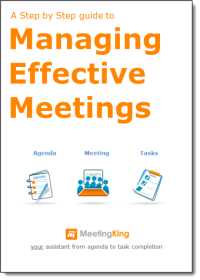 Carrying out job interviews can be a challenge. It can be hard to make sure that you ask each candidate the same questions, while at the same making sure the conversation has a natural flow and feel.
Carrying out job interviews can be a challenge. It can be hard to make sure that you ask each candidate the same questions, while at the same making sure the conversation has a natural flow and feel.
Hiring people is a costly exercise, and it is something that you don’t want to get wrong. Hiring the wrong person at the least means going through the process of hiring and training all over again, in addition to possible costs of firing an employee. This is expensive, and should be avoided at all costs. Good hiring requires structure, consistency and planning, as well as a logical and organized approach to the interview process.
To better structure your job interviews and to keep them consistent from candidate to candidate you can use MeetingKing’s “Interview Job Applicant” template. This template helps you to be able to run job interviews more smoothly. You can use the template as is or modify it to your needs. You can easily create different kinds of templates for interviews depending on what kind of job you are interviewing for. This means you can compare candidates like for like by always asking them the same questions.
Commonly asked interview questions are:
- Tell me about yourself and why should we hire you?
- What are you strengths?
- What are your weaknesses?
- Why are you leaving your current job?
- Where do you want to be in five years?
These questions are already found in the standard MeetingKing job interview template for your convenience. The questions are set up in a logical order in the template, but it is very easy to create your own order by dragging topics to a different location. You can also delete questions if you prefer not to ask them. These are suggestions only.
You can include new questions of your own also. Simply add new topics to the interview. This is useful if you want to ask questions that are specifically related to the position itself, such as technical questions like:
- “What is your experience with…?”
- “How do you handle problem X?”
- “For how many years have you been working with program Y?”
- “What is the most important aspect to consider in situation Z?”
All of these types of questions can help you to really understand the candidate’s specific job experience and get to the bottom of whether or not they would be a high performer in your role. Once you are happy with the structure of your interview you save it as a new template. More information on templates.
During the interview itself, it is easy to type notes into the template that you have created. These notes are then stored in the system for you to be able to refer back to at any time. You can also give the HR manager or department manager access to your interview meetings, so they can compare candidates as well. By using tags, e.g. ”interview position XYZ”, it is really easy to find all the interviews and related action items for a certain position.
With all information in one place and a consistent structure to your interviews, you will be able to compare candidates objectively. Just switch between the interview meetings of the top candidates and compare the different answers that were given to the questions that you asked. This also leads to a fairer interview process for candidates. Being well informed will make it easier to come to a solid hiring decision.


